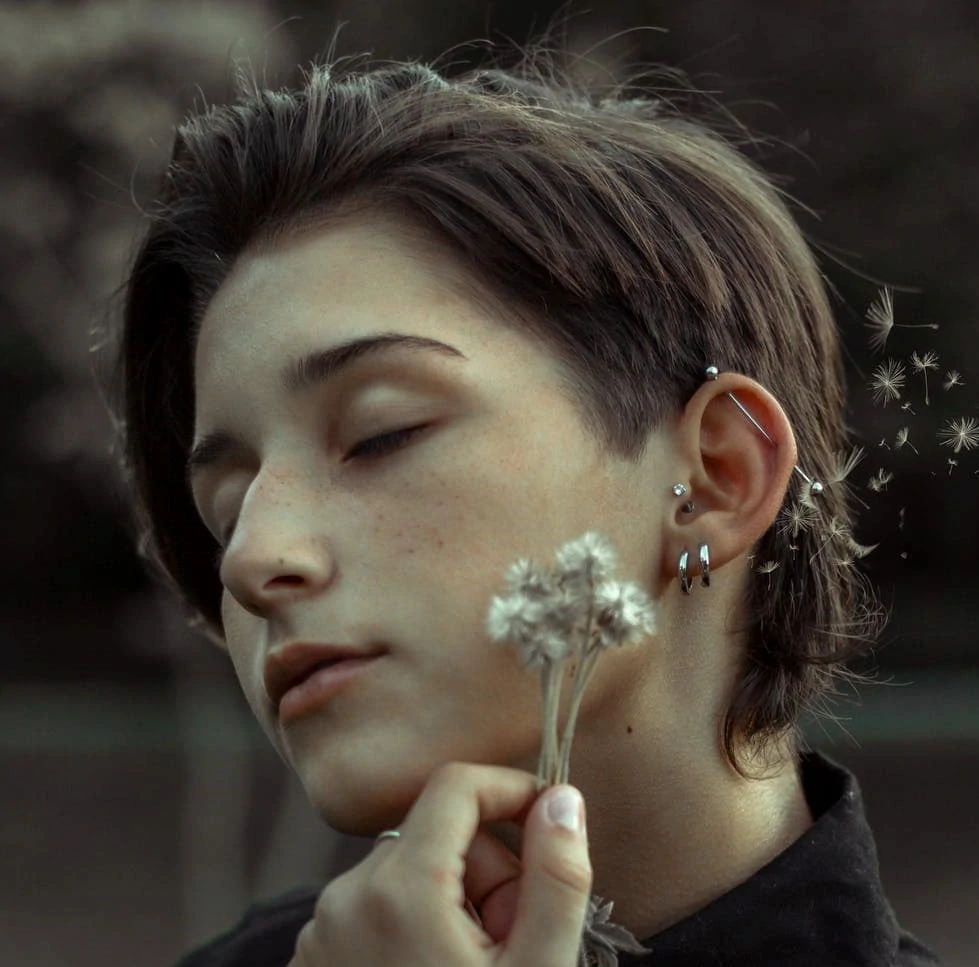
Table of Contents
As upper ear piercings gain popularity, many are on the hunt for a distinctive style to set them apart. Enter the industrial piercing—a bold statement that artfully connects two piercings with a single striking piece of jewelry.
Intrigued? Here’s everything you need to know about industrial piercings to help you decide if this standout look is the perfect fit for your aesthetic.
What is the Industrial Piercing?
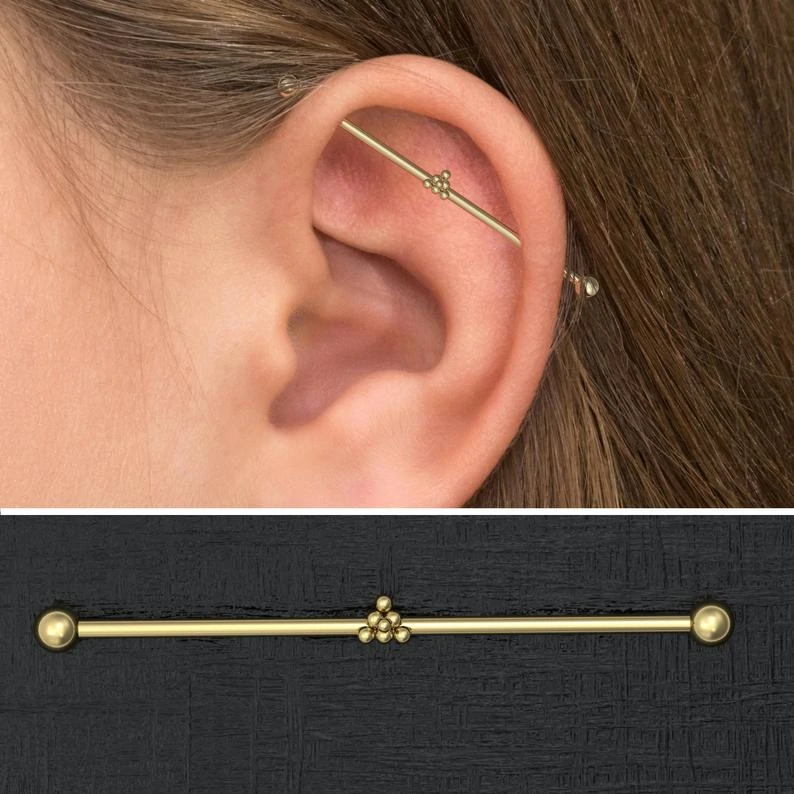
While the name may be dull, an industrial piercing is one of the more striking ear piercings that you can adorn your ears with.
Technically, an industrial piercing is two individual cartilage piercings that are joined together with a single bar earring that threads through the ear at both ends. The adjoining bar is the reason why industrial piercings are often called ‘scaffolding piercings’, ‘the bar’ or ‘construction piercings.’
Industrial piercings can join several different cartilage piercings but the most common joins the helix and the anti-helix piercings with the bar running across the top of the ear.
Other placements include a vertical double conch that runs up through the inside of the ear; a short rook-daith in the inner ear; an anti-helix-rook that runs across the common double helix piercing and, a daith-lower conch that follows the same direction as the double helix placement, but over the inner ear.
What’s the Best Type of Jewelry for Your Industrial Piercing?
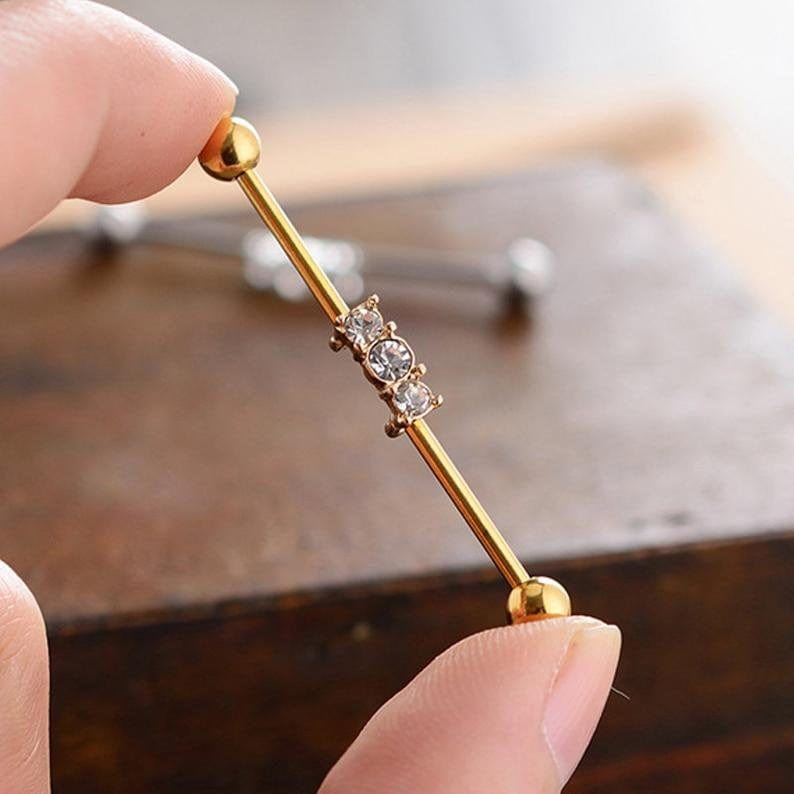
Industrial piercings stand out with their signature barbell spanning two piercings. These barbells, longer studded posts, come with threaded backings at both ends. Often, you’ll find design elements on these backings, like stones, charms, or balls. Even the bar itself can boast designs from stones and twisted metal to specific motifs.
Your jewelry options for this piercing type seem endless, with designs for every style. Minimalists might prefer plain barbells, while others may gravitate towards diamond-encrusted ones or even bohemian feather and arrow charms. But beyond style, ensuring the right fit is crucial. Aim for a gauge— or the thickness of the post— that’s slightly larger than standard earrings, typically around 14G. Remember, the barbell’s length should match your ear size and piercing placement.
Initially, choose a slightly longer barbell to avoid the threaded balls pressing too close during the healing process. If they sit too snugly, they could become embedded in your ear. Conversely, a bar too long can easily snag on hair or clothing.
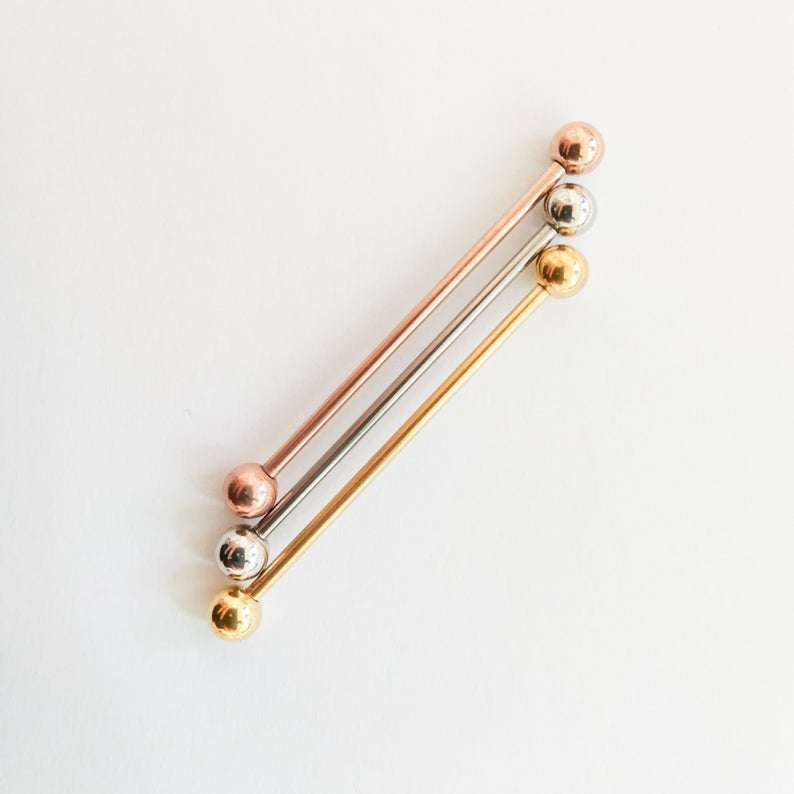
When selecting jewelry, prioritize:
- Material: Hypoallergenic materials like surgical stainless steel, titanium, niobium, or 14k and 18k gold work best for both new and healed piercings.
- Length: With swelling common after piercing, start with a longer barbell. As the piercing heals, you can switch to something shorter and snugger.
- Gauge: While 14G is the standard, consult your piercer for the best size for your ear.
- Designs: From simple ball ends to unique shapes and designs, there’s a wide array to choose from.
- Comfort: Ensure that your jewelry doesn’t press into your head, especially when resting or wearing headphones.
What are the Pros and Cons of Industrial Piercings?
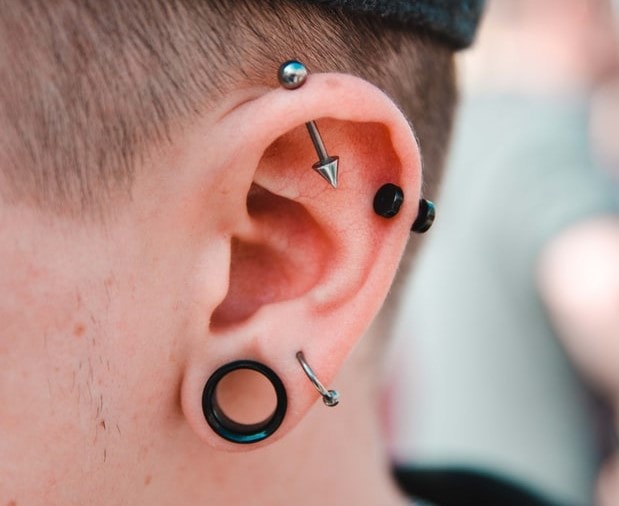
Like any body modification, there are advantages and disadvantages to consider before getting one. Here’s a quick look:
Pros:
- Offers a distinct and edgy look that stands out from more traditional piercings.
- Once healed, there’s a wide array of barbell designs and styles to choose from.
- You can change the position and angle to best suit your ear’s anatomy and desired aesthetic.
- Acts as a statement piece, allowing wearers to showcase their personality and style.
Cons:
- Typically takes longer to heal than other piercings, ranging from a few months to over a year.
- Due to the longer barbell, there’s increased movement which can introduce bacteria and delay healing.
- The body might push the piercing towards the skin surface, leading to migration or, in rare cases, complete rejection.
- If improperly cared for, or if there’s an adverse reaction, there’s a risk of unsightly scars.
- Initially, wearing over-the-ear headphones or hats may be uncomfortable.
Will an Industrial Piercing hurt?

It depends on individual pain thresholds, but for the most part, yes, you will experience some pain as a result of an industrial piercing. The actual piercing of your ear will only hurt for as long as it takes the needle to pass through the ear which is usually only a few seconds.
But as with all cartilage piercings, this is more painful because the skin is thicker on the upper ear. You will also have to live with tender ears for longer as you wait for the piercings to heal.
Industrial Piercing Aftercare
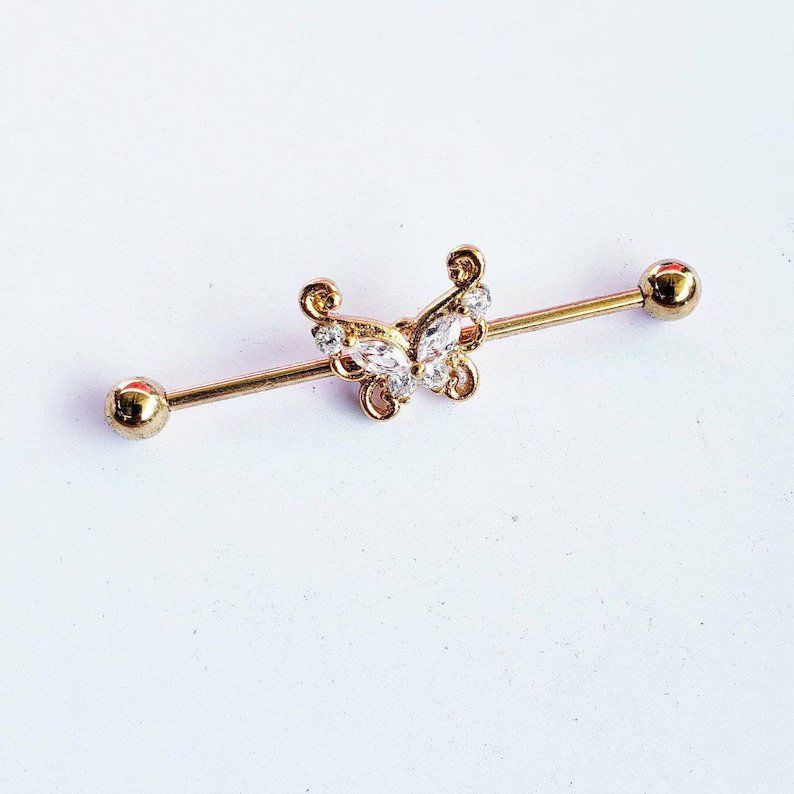
Most industrial piercings follow with about a week of swelling and will take about 2-6 months to heal completely. Industrial piercings take longer to heal because of their placement and because of the potential for irritation from the bar. The healing process can also be cyclical, meaning that periods of good healing can be followed by periods of soreness. This is normal until the piercing has healed completely.
To care for your new industrial piercing, you should be stringent with aftercare. In simple terms, this means keeping the area clean and leaving it alone as much as possible. You should avoid harsh cleansers that include alcohol or hydrogen peroxide. Your piercer will be able to provide you with a cleaning solution and regime.
Keeping hair and clothing away from the piercing will help to keep it clean and also minimize the potential for catching. You should also avoid sleeping on your ear while the piercing is fresh as this will add unnecessary pressure. It is also a good idea to keep the original earring in the piercing until it is completely healed as changing jewelry can disrupt the healing process and cause scarring.
What’s the Cost of an Industrial Piercing?
The cost of a piercing will depend on many factors, including the experience of the piercer and the reputation of the salon. Industrial piercings can cost roughly between $30 and $90, and though the higher end of this spectrum may seem expensive, remember that you are actually paying for two cartilage piercings which are much more difficult than piercings on the lobe.
This is because ear lobe piercings are usually done with a piercing gun that uses an earring and the force of a gun to make the incision. Cartilage piercings require a hollowed needle to pass through the thick skin of the cartilage without causing injury. The intricacy of a needle requires more skill, particularly if piercings need to be precise, as is the case with an industrial piercing that needs to line up perfectly. This is where you should be willing to do your research and pay a little more for the services of an expert.
Is the Industrial Piercing Right for You?
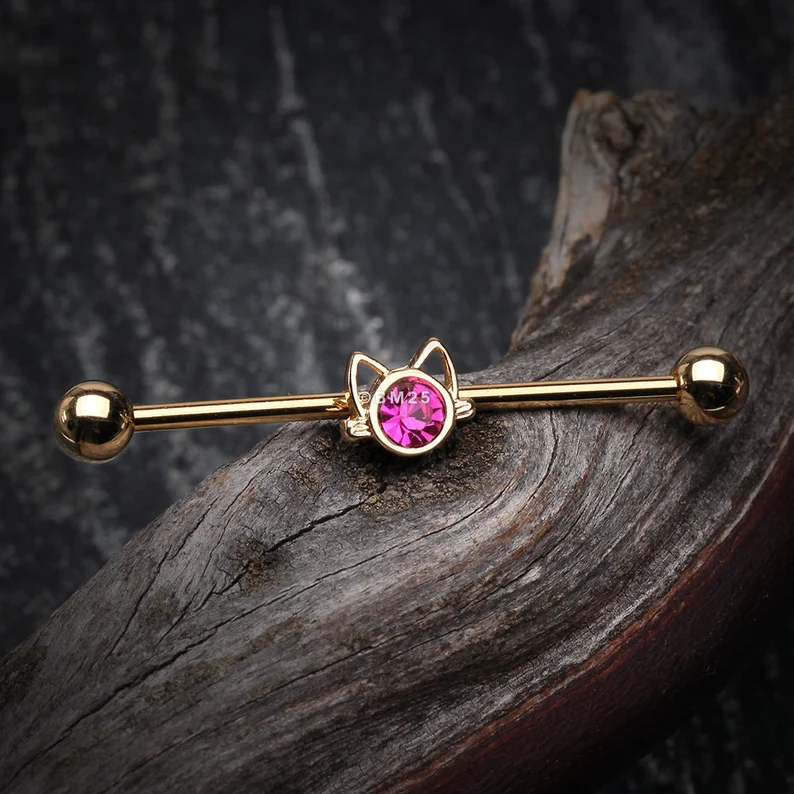
There are many factors to consider when it comes to an industrial piercing and determining whether they are worth it will largely be a personal choice.
For many people, pain and cost can be a major factor. If this is the case for you, a solution may be to leave more time in between each piercing so that you can focus on healing (and paying for) one at a time.
This can be a good plan if you are new to cartilage piercings as you can use your first piercing to test the water. Just be sure that you let your piercer know that you may want to wear an industrial barbell in the future so that they can take greater care with placement.
Wrapping Up
Industrial piercings make a strong style statement. They have their ups and downs, but they stand out and let you express yourself. Remember to always make informed choices and seek expert advice to ensure a smooth piercing journey.









